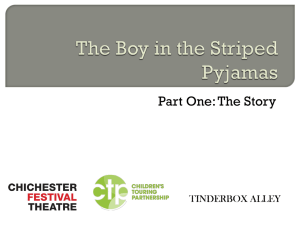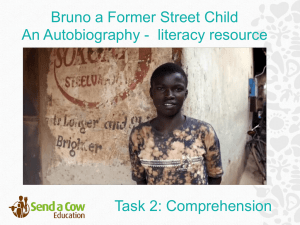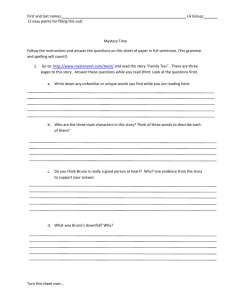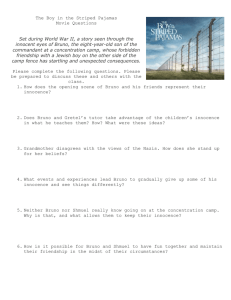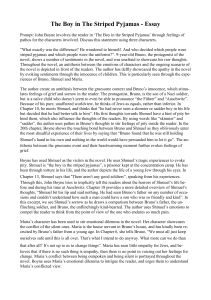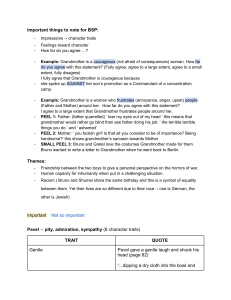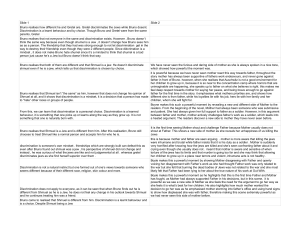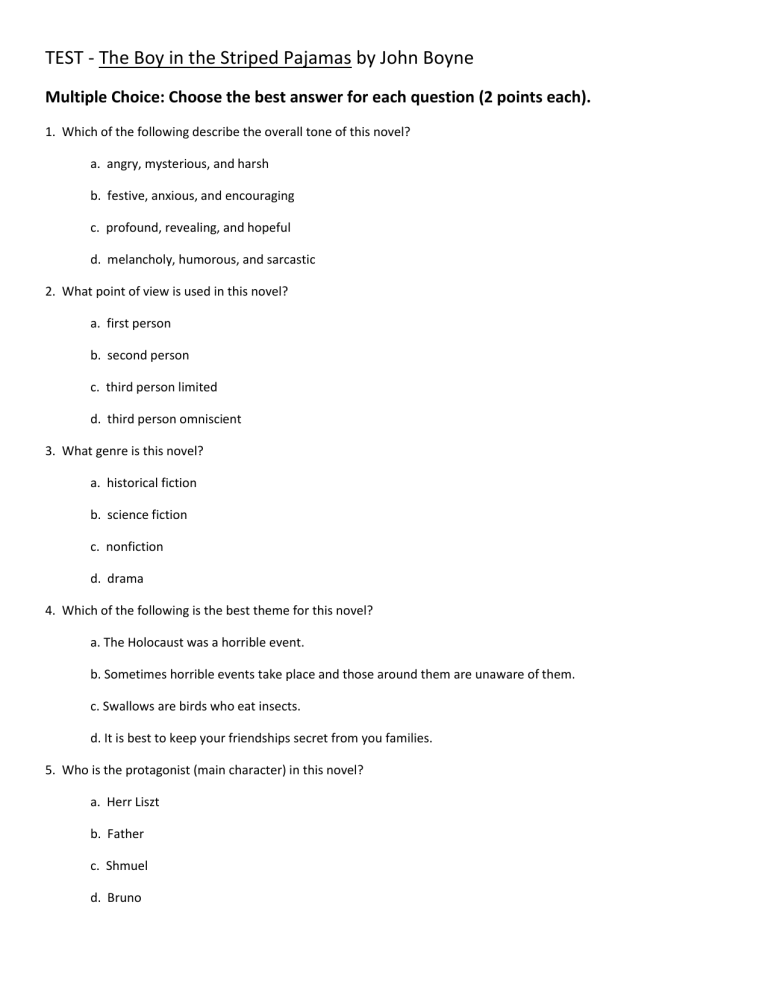
TEST - The Boy in the Striped Pajamas by John Boyne Multiple Choice: Choose the best answer for each question (2 points each). 1. Which of the following describe the overall tone of this novel? a. angry, mysterious, and harsh b. festive, anxious, and encouraging c. profound, revealing, and hopeful d. melancholy, humorous, and sarcastic 2. What point of view is used in this novel? a. first person b. second person c. third person limited d. third person omniscient 3. What genre is this novel? a. historical fiction b. science fiction c. nonfiction d. drama 4. Which of the following is the best theme for this novel? a. The Holocaust was a horrible event. b. Sometimes horrible events take place and those around them are unaware of them. c. Swallows are birds who eat insects. d. It is best to keep your friendships secret from you families. 5. Who is the protagonist (main character) in this novel? a. Herr Liszt b. Father c. Shmuel d. Bruno 6. Gretel can best be described as being __________________. a. a round and static character b. a round and dynamic character c. a flat and static character d. a flat and dynamic character 7. Who does Bruno refer to as a Hopeless Case? a. his sister b. his babysitter c. Father’s secretary d. Father’s mother 8. In the passage, which of the following roots meaning earth is found? “But we learn in geography class that in the countryside, where all the farmers are and the animals, and they grow all the food, there are huge areas like this where people live and work and send food to feedus.” a. farm b. gro c. geo d. graph 9. What is Bruno able to see from his bedroom window? a. farm animals b. a city, crowds c. men, boys d. a vegetable garden 10. What type of figurative language is used in this passage? “I don’t like it here,” he said for the hundredth time. a. hyperbole b. idiom c. metaphor d. simile 11. Based on the narrator’s description, we can infer that “Out-With” is a(n) ____. There was a huge wire fence that ran the length of the house and turned in at the top, extending further along in either direction, further than she could possibly see. The fence was very high, higher than the house they were standing in, and there were huge wooden posts, like telegraph poles, dotting along it, holding it up. At the top of the fence enormous bales of barbed wire were tangled in spirals… a. a countryside village b. a farm in deer territory c. a concentration camp d. an industrial park 12. Which of the following words found in the passage contain the Greek root meaning “write”? a. extending b. enormous c. telegraph d. spirals 13. Who is the oldest? a. Bruno b. Lieutenant Kotler c. Gretel d. Shmuel 14. Who passed away in Berlin while the family is at “Out With”? a. Lieutenant Kotler b. Mother c. Grandmother d. Grandfather 15. Passed away is a(n) __________________ meaning __________________. a. idiom, died b. idiom, moved to a different place c. euphemism, died d. euphemism, moved to a different place 16. Which of the following best describes Bruno’s relationship with his sister? a. love/hate b. soothing c. soothing/complicated d. somber 17. Pavel, the waiter, was really a _____________. a. barber b. soldier c. teacher d. doctor 18. Which of the following best describes Bruno’s Mother’s attitude about “Out-With”? a. She loves living there. b. She is unhappy there. c. She is eager to remodel there. d. She enjoys being a leader there. 19. What did Shmuel want Bruno to help him to do on their “Final Adventure”? a. help him find some extra food b. help him find his father c. help him plan an escape d. help him find clothes for the small children 20. Which of the following best describe Bruno’s perception of the concentration camp at “Out-With”? a. He was oblivious and ignorant as to what was really happening. b. He was horrified once he realized that people were being killed. c. He was very sad and worried over the concentration camp. d. He was angry with his father for being involved with the concentration camp. 21. At the end of the novel, the reader can infer that Bruno and Shmuel ________________ a. are killed in a gas chamber. b. escape and run away. c. march to the next town. d. disappear into darkness. 22. Which of the following is not a theme in this novel? a. You reap what you sow. b. Terrible things can take place without you even realizing it. c. It is better to have loved and lost than never to have loved at all. d. Good and evil will always be present in this world. Identification: Identify the type of figurative language in each of the following passages for questions 23-25 . Answers MAY be used more than once (2 points each). a. hyperbole b. idiom c. metaphor d. personification e. simile 23. Gretel didn’t rise to the bait on that one. ____________ 24. …Lieutenant Kotler saying, “Don’t worry, this one knows which side his bread is buttered on,” and… ____________ 25. The rain would surely have stopped by then …but it showed no signs of slowing down and even pounded noisily against the window. ____________ Vocabulary: Define each of the following words. Partial credit may be given (2 points each). 26. dilemma 27. crucial 28. catastrophe 29. extravagant 30. traitors 31. vital 32. inconsolable 33. scarcely 34. appallingly 35. obliged Open Response: Answer the following questions in one to two paragraphs. Use proper punctuation, capitalization and grammar (30 points). 36. How does Bruno change throughout the book? What remains the same about him and how he thinks? What changes about him and how he thinks? List AT LEAST THREE things that change about Bruno in your response and explain using specific details and/or examples.
